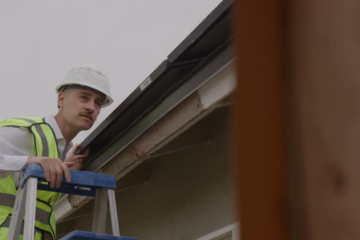Understanding the different types of gutters is important for protecting your home from leaks and water damage. With the right choice, you can improve both your home’s appearance and its ability to handle heavy rain.
From K-style and half-round to seamless and box designs, each gutter type offers unique benefits. This guide will help you compare materials, styles, and functions so you can select the one that fits your home perfectly.
Table of Contents
Why Gutters Are Important
Gutters aren’t just decorative features; they are vital for protecting your home. Properly installed gutters:
- Direct rainwater away from walls and foundations
- Prevent soil erosion around your property
- Protect landscaping from heavy runoff
- Reduce the risk of basement flooding
Choosing the wrong style or neglecting maintenance can lead to costly repairs. That’s why understanding different types of gutters is essential.

Different Types of Gutters
There are several gutter styles available, each designed for specific needs. Some of the most common include:
K-Style Gutters
K-style gutters are the most popular choice for modern homes. They have a flat bottom and a decorative front edge that resembles crown molding. These gutters handle large volumes of water efficiently, making them suitable for areas with heavy rainfall.
Half-Round Gutters
Half-round gutters feature a smooth, semi-circular shape often seen in historic or traditional homes. Their design allows water to flow smoothly, reducing debris buildup. However, they have a slightly lower capacity than K-style gutters and may require more frequent cleaning.
Box Gutters
Box gutters are large, rectangular channels often built into the roof edge. They can handle heavy rainfall and are ideal for flat or low-pitch roofs. Installation is more complex and usually requires professional expertise.
Seamless Gutters
Seamless gutters are custom-fitted from a single sheet of metal, reducing leaks and minimizing maintenance. They require professional installation but provide long-term durability and performance.
Different Types of Rain Gutters
Rain gutters are specifically designed to manage rainfall efficiently. The different types of rain gutters ensure that water is directed away from your home without causing damage.
Aluminum Rain Gutters
Lightweight, rust-resistant, and available in a variety of colors, aluminum gutters are both practical and affordable.
Copper Rain Gutters
Copper gutters are extremely durable and develop a unique patina over time, offering a blend of longevity and aesthetic appeal.
Vinyl Rain Gutters
Vinyl gutters are budget-friendly and suitable for DIY installation. However, they are less durable in extreme weather conditions.
Steel Rain Gutters
Steel gutters are strong and ideal for areas with heavy snow, though they require anti-rust coatings to prevent corrosion.
By understanding the types of rain gutters, homeowners can select the best combination of material and style for their property.
Types of Roof Gutters
Matching gutters to your roof type is essential for optimal performance. Here are the common types of roof gutters:
- Flat Roof Gutters: Usually box-style, designed to manage slower water flow.
- Sloped Roof Gutters: K-style or half-round gutters work best for standard residential roofs.
- Metal Roof Gutters: Special fasteners and expansion allowances are required.
- Tile Roof Gutters: Custom shapes that align with tile edges to prevent overflow.
Choosing the right types of roof gutters ensures efficient drainage and reduces maintenance issues.
Types of Guttering Profiles
Guttering profiles define the shape and structure of the gutter system. The types of guttering profiles include:
- K-Style Profile: Versatile and widely used in modern homes.
- Half-Round Profile: Traditional look with smooth water flow.
- Box Profile: Heavy-duty option for large buildings or commercial properties.
- Hidden/Fascia Profile: Integrated into the roof edge for a clean, modern appearance.
Selecting the right profile combines functionality with aesthetics, enhancing both water management and curb appeal.
Types of Gutters for Metal Roofs
Metal roofs need specialized gutter solutions due to thermal expansion and fastener requirements. The types of gutters for metal roofs include:
- K-Style Metal Gutters: Secure and compatible with most metal roof systems.
- Half-Round Metal Gutters: Smooth design prevents water and debris buildup.
- Seamless Metal Gutters: Custom-fit, minimize leaks, and accommodate temperature changes.
- Box Metal Gutters: Suitable for large industrial or commercial roofs with heavy rainfall.
Proper selection ensures durability, reduces maintenance, and protects the home’s structure.
Gutter Materials: Choosing the Right One
The material of your gutter affects longevity, appearance, and maintenance needs. Common options include:
- Aluminum: Lightweight, rust-resistant, and budget-friendly.
- Copper: Extremely durable with a visually appealing patina over time.
- Steel: Strong and ideal for snow-heavy regions but requires rust protection.
- Vinyl: Affordable and easy to install, but less durable under extreme weather.
Consider your climate, budget, and home style when choosing the gutter material.
Gutter Maintenance Tips
Maintaining gutters extends their life and ensures they function effectively:
- Clean gutters regularly to remove leaves and debris.
- Inspect for cracks, rust, and loose fasteners.
- Ensure gutters have the proper slope for water flow.
- Install gutter guards to reduce debris accumulation.
Regular maintenance prevents water damage and prolongs the life of your gutter system.
How to Choose the Right Gutter System
When selecting a gutter system, consider:
- Roof Type & Slope: Ensure gutters match the roof design for proper drainage.
- Climate: Areas with heavy rain or snow may require K-style or box gutters.
- Material: Balance cost, durability, and visual appeal.
- Maintenance Level: Seamless gutters or those with guards reduce upkeep.
- Home Style: Half-round suits traditional homes; K-style complements modern designs.
A carefully chosen system ensures both protection and aesthetic harmony.
Installation Considerations
Professional installation is recommended for:
- Seamless gutters (custom-fitted for accuracy)
- Box gutters (complex design)
- Metal roof gutters (fastener and expansion requirements)
DIY installation is feasible for vinyl or standard aluminum gutters, provided proper slope and secure fastening are ensured.
Conclusion
Selecting the right gutter system is critical for protecting your home from water damage while enhancing its aesthetic appeal. By understanding the types of gutters, different types of rain gutters, types of roof gutters, and types of gutters for metal roofs, homeowners can make informed decisions tailored to their home, budget, and climate.
Proper maintenance, suitable materials, and professional installation ensure your gutter system performs efficiently for years, keeping your home safe and beautiful.

